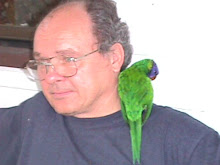I got in a third shot; the bird was distinctly jittery by now.
The second shot, a “D”.
The third shot for which I award myself a “C”, more for the effort than the photographic niceties.
The Backyard List of birds seen on our 7½-acres property at 63 Allen Road, NANANGO, Queensland, Australia. It includes sightings made while walking/driving along Allen Road.
I got in a third shot; the bird was distinctly jittery by now.
The second shot, a “D”.
The third shot for which I award myself a “C”, more for the effort than the photographic niceties.
 Our residence in Allen Road has a history dating back to April 2001 when we initially inspected the vacant block [the tin shed was empty at the time]. The house, from a Toowoomba “house yard,” was moved in situ the following year; weekends were fully occupied in renovating, first the exterior, later the interior. In March 2005 Fay left her position with QML [after more than 20 years with the company] to take up employment with a small research company attached to PCA in Kingaroy. I sought, and was granted, a teaching transfer into the region at the end of 2005. The renovations to the house and improvements to the property in general continued, still continue to this day.
Our residence in Allen Road has a history dating back to April 2001 when we initially inspected the vacant block [the tin shed was empty at the time]. The house, from a Toowoomba “house yard,” was moved in situ the following year; weekends were fully occupied in renovating, first the exterior, later the interior. In March 2005 Fay left her position with QML [after more than 20 years with the company] to take up employment with a small research company attached to PCA in Kingaroy. I sought, and was granted, a teaching transfer into the region at the end of 2005. The renovations to the house and improvements to the property in general continued, still continue to this day. 
In more recent times, while the steady accumulation of data for its own sake continues, Fay and I have come to recording the early morning avian risers. Not the songs themselves [we don’t have the equipment to venture along that path] but the actual species involved in our local Dawn Chorus.
If you asked the average Australian, birder or non-birder, to venture a guess as to which species would be “Top of the Dawn Chorus Pops,” I’d be more than mildly surprised if the over-whelming response was anything other than Laughing Kookaburra Dacelo novaeguineae. Many of the Indigenous peoples of Australia share the same Dreamtime tale of how the Spirits, having discovered the wonder of sunrise, asked Kookaburra if he would herald its arrival each morning so that all the creatures could enjoy this phenomenon.
And, of course, within certain caveats, they are all right. On average, over the space of a year, the Laughing Kookaburra is almost invariable the earliest precursor of dawn. Almost always… but not quite always.
It is, on occasions, bettered by other species. The Masked lapwing Vanellus miles springs immediately to mind. The Australian Wood Duck Chenonetta jubata is another serious contender for the title of Early Bird Champion. The humble Australian Magpie Cracticus tibicen and Torresian Crow Corvus orru have been known to call before old kookaburra stirred from his slumbers. Even the diminutive Willie Wagtail Rhipidura leucophrys was once heard well before the official setting for sunrise, albeit from across the other side of Allen Road where neighbours were holding an all-night party. The Pied Currawong Strepera graculina was among the first early risers recorded to have ousted the Laughing Kookaburra from it near unassailable throne.
On at least two occasions in January this year alone the Common Bronzewing Phaps chalcoptera has pipped them all to the post. The Eastern Koel Eudynamys orientalis, a summer migrant, has been recorded as the earliest caller on at least one occasion in the past couple of years.
Yet, in spite of all these excepti0ns to the case, as already stated, in general, at least along Allen Road, the Laughing Kookaburra can often call several times prior to any other bird acknowledging the advent of dawn.



